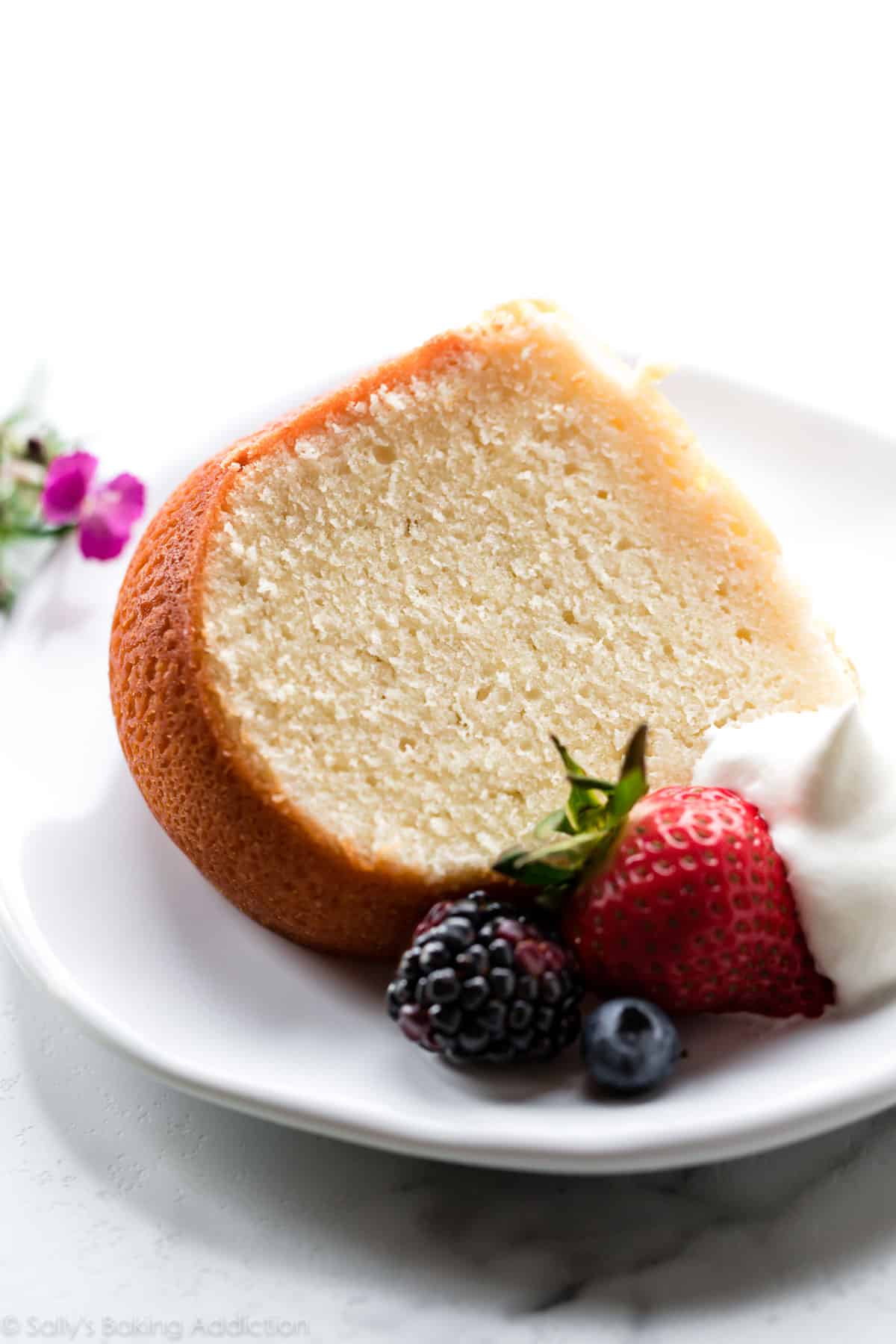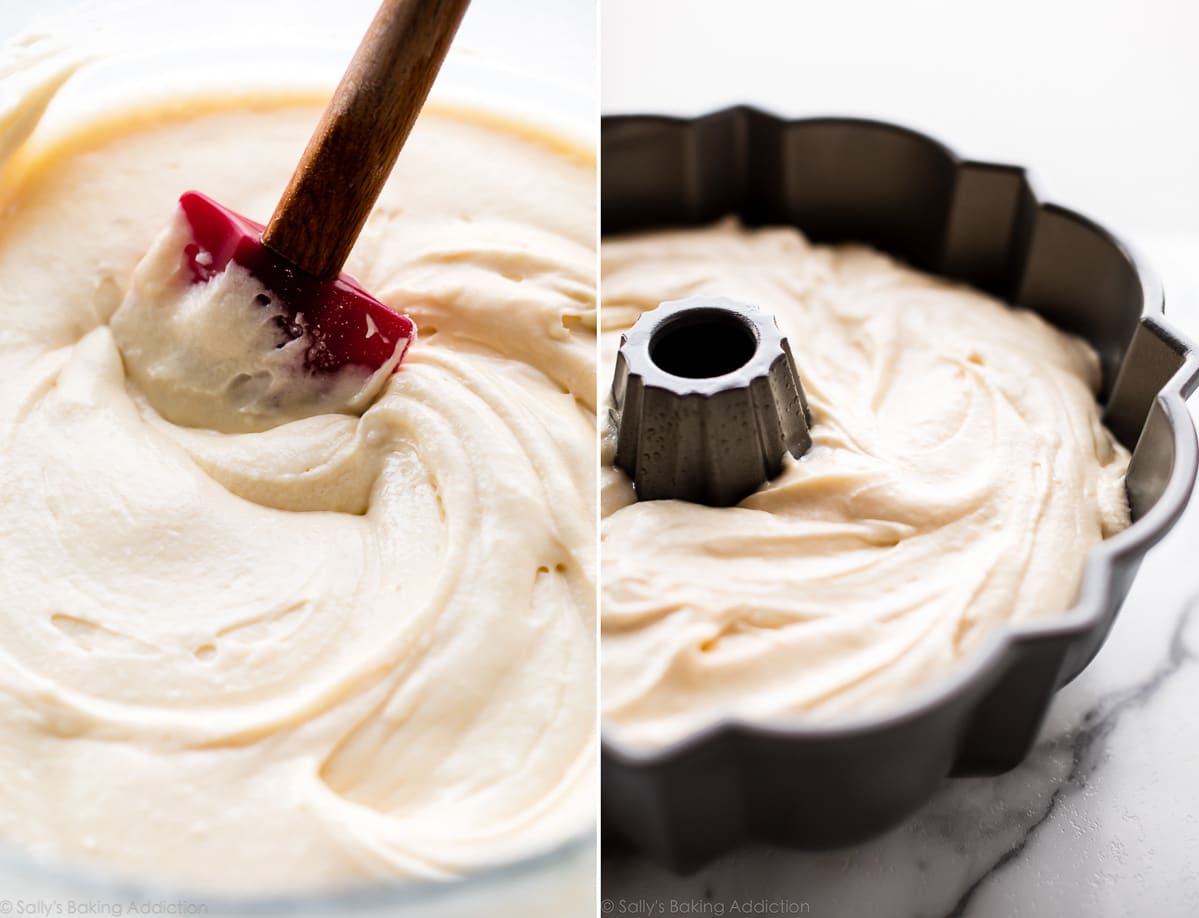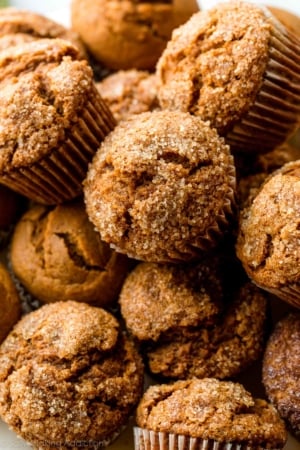This recipe produces a perfect cream cheese pound cake. After persistent recipe testing with many failures, I found the best ratio of ingredients to produce a moist, dense, and flavorful pound cake. Using 9 simple ingredients, this cream cheese pound cake recipe will be your new favorite. To prevent a ruined cake, follow the baking time and temperature closely.

Until recently, I had never made really good plain pound cake. I have delicious lemon pound cake, raspberry swirl pound cake, and brown butter pound cake in my back pocket, but regular pound cake has always been a disappointment. It was so hard for me to tackle this recipe because pound cake can easily turn out dry, rock solid, and/or lacking flavor.
But then I began adding cream cheese and sour cream to the cake batter. And my long history of pound cake disappointments began fading away.

Here’s Why You’ll Love This Pound Cake Recipe
Today I’m teaching you how to make my favorite cream cheese pound cake in a Bundt pan. I’m confident this is the best pound cake and I’m showing you exactly why:
- Very buttery & very moist
- Not dry
- 1 bowl recipe
- Only 9 basic ingredients
- Dense, but not heavy as a brick
- Soft & smooth crumb
- A little tang from cream cheese
- Sweet & vanilla flavored
You can easily halve this recipe for a loaf pan or try my mini pound cakes recipe.

Ingredients You Need & Why
Here are the ingredients for cream cheese pound cake and why each is used.
- Butter: Butter is the base of pound cake. You need 3 sticks of room temperature butter.
- Cream Cheese: Cream cheese is the difference between dry pound cake and moist pound cake. End of story. If you’ve experienced dry pound cake before, cream cheese will solve all those problems. I swear by it and you will too! Full-fat brick-style cream cheese (not the spreadable kind in a tub) is imperative here, just like for classic cheesecake and cream cheese frosting.
- Sugar: This is a very large cake, so a lot of sugar is required to sweeten the cake and properly cream all the butter and cream cheese. 2 and 1/2 cups seems like a lot, but remember this cake is heavy and yields many servings.
- Sour Cream: Sour cream is an unconventional ingredient in pound cake, but it adds so much moisture. We are avoiding dry pound cake as much as we can!
- Vanilla Extract & Salt: Both are used for flavor. See recipe notes for more flavors.
- Eggs: Eggs are the workhorse of pound cake—the main ingredient carrying all the weight. You can’t make pound cake without eggs.
- Cake Flour: Cake flour is lighter than all-purpose flour and produces the best pound cake in my opinion. Since it’s so light, the attention remains on the butter. All-purpose flour is simply too heavy for this pound cake recipe; the cake will be heavy as a brick. If needed, use this homemade cake flour substitute.
- Baking Powder: Baking powder is another unconventional ingredient in pound cake. I don’t use much for this amount of batter, but the small amount lightly lifts the crumb so the cake isn’t overly heavy and squat.
Each ingredient is important and has a very specific job!


Pound Cake Disasters: Don’t Do This
And now it’s time to discuss what can go very wrong with pound cake. I’m sharing my mistakes so you don’t waste time or ingredients. The picture below shows 2 pound cake disasters I experienced before landing on the perfect pound cake recipe and method.
- Mistake #1 – Left Picture: This is seriously under-cooked pound cake baked at 350°F (177°C). This temperature is TOO HOT for pound cake, which is mostly butter and eggs, to cook evenly. As you can see below, the exterior will brown before the center is cooked. I was so upset cutting into this cake. It looked perfect on the outside.
- Mistake #2 – Right Picture: This is seriously over-cooked pound cake. Learning from mistake #1, I cooked the pound cake at 325°F (163°C). I was so nervous to under-bake the pound cake, so I over-baked it. The cake wouldn’t release from the pan, even though it had been generously greased.
These cakes were just awful!

Here’s How You Make The Most PERFECT Pound Cake
Now that you know what can go wrong, let’s talk about how to make the most perfect cream cheese pound cake. The *TRICK* is a lot of mixing before you add the eggs.
- Mix, mix, mix: Beat the butter until creamy. Add the cream cheese, then beat the two until smooth. Get all the cream cheese lumps out. Beat in the sugar, then add the sour cream and vanilla. So far there’s been a lot of mixing and that’s ok!
- 1 egg at a time: Add the eggs 1 at a time, making sure each is incorporated before adding the next. When the eggs are room temperature, the mixer only needs a few turns and won’t over-mix them. Over-mixed batter = heavy-as-a-brick cake.
- Add dry ingredients: Add the dry ingredients right into the same mixing bowl.
- Pour into pan: Pour the batter into a generously greased 10-12 cup Bundt pan. This is totally not sponsored, but I absolutely adore Nordic Ware Bundt pans. Make sure you use one that holds 10-12 cups of batter. This one is also gorgeous! 🙂
- Bake: Bake the cream cheese pound cake at 325°F (163°C). Halfway through baking, loosely tent the cake with aluminum foil to prevent over-browning.
- Cool, then invert: Let the pound cool for about 2 hours in the pan, then invert onto a serving plate and cool completely before serving.
Serve with whipped cream, fresh berries, raspberry sauce, strawberry sauce, blueberry sauce, and/or homemade lemon curd. The topping from my pecan pie cheesecake would also be fantastic spooned over each slice. There’s a simplistic beauty about pound cake—it doesn’t need glaze, frosting, bells, or whistles.


4 Final Success Tips
Enough from me! Let me leave you with 4 tips before you get started.
- Follow the recipe. Use the ingredients and measurements listed.
- Bake low and slow. Pound cake is a large heavy cake and requires a cooler oven. Don’t be alarmed if your cake takes longer than 90 minutes.
- Bring all ingredients to room temperature before beginning. Room temperature ingredients promise a uniformly textured cake. Cold ingredients do not emulsify together and the pound cake won’t bake properly.
- Make sure each egg is mixed in before adding the next.

Cream Cheese Pound Cake
- Prep Time: 15 minutes
- Cook Time: 1 hour, 20 minutes
- Total Time: 4 hours
- Yield: serves 12-14
- Category: Dessert
- Method: Baking
- Cuisine: American
Description
This recipe produces a perfect cream cheese pound cake. After persistent recipe testing with many failures, I found the best ratio of ingredients to produce a moist, dense, and flavorful pound cake. Using 9 simple ingredients, this cream cheese pound cake recipe will be your new favorite. To prevent a ruined cake, follow the baking time and temperature closely. Learn from my mistake!
Ingredients
- 1 and 1/2 cups (340g) unsalted butter, softened to room temperature
- 8 ounce (226g) full-fat brick cream cheese, softened to room temperature
- 2 and 1/2 cups (500g) granulated sugar
- 1/3 cup (80g) sour cream, at room temperature
- 2 teaspoons pure vanilla extract
- 6 large eggs, at room temperature
- 3 cups (354g) cake flour (spooned & leveled)
- 1/2 teaspoon baking powder
- 1/8 teaspoon salt
- optional for serving: homemade whipped cream & fresh berries
Instructions
- Preheat oven to 325°F (163°C). Not 350°F. Generously grease a 10-12 cup Bundt pan with butter or nonstick spray.
- Using a handheld or stand mixer fitted with a paddle or whisk attachment, beat the butter on high speed until smooth and creamy, about 2 minutes. Scrape down the sides and up the bottom of the bowl with a rubber spatula. Add the cream cheese and beat on high speed until completely smooth and combined, about 1 minute. Add the sugar and beat on high speed until combined, about 1 minute, then add the sour cream and vanilla and beat on high speed until combined and creamy. Scrape down the sides and up the bottom of the bowl with a silicone spatula.
- On low speed, beat the eggs in 1 at a time allowing each to fully mix in before adding the next. Careful not to overmix after the eggs have been added. Once the 6th egg is combined, stop the mixer and add the cake flour, baking powder, and salt. Beat on medium speed *just* until combined. Do not overmix. Using a silicone spatula or sturdy whisk, give the batter a final turn to make sure there are no lumps at the bottom of the bowl. The batter will be a little thick and very creamy.
- Pour/spoon batter evenly into prepared pan. Bang the pan on the counter once or twice to bring up any air bubbles. Bake for 75-95 minutes. Loosely tent the baking cake with aluminum foil halfway through bake time to ensure the surface does not over-brown. The key to pound cake is a slow and low bake time. Use a toothpick to test for doneness. Once it comes out completely clean, the pound cake is done. This is a large heavy cake so don’t be alarmed if it takes longer in your oven. If it needs longer, bake longer.
- Remove cake from the oven and allow to cool for 2 hours inside the pan. Then invert the slightly cooled pound cake onto a wire rack or serving dish. Allow to cool completely.
- Slice and serve with optional toppings like homemade whipped cream & fresh berries.
- Cover leftover cake tightly and store at room temperature for up to 2 days or in the refrigerator for up to 5 days.
Notes
- Freezing Instructions: Wrap baked and cooled pound cake in 1-2 layers of plastic wrap, then a layer of aluminum foil. Freeze for up to 3 months. Allow to thaw in the plastic wrap & foil overnight in the refrigerator, then bring to room temperature before slicing and serving.
- Special Tools (affiliate links): 10-12 Cup Bundt Pan | Electric Mixer (Handheld or Stand) | Silicone Spatula | Whisk | Cooling Rack
- Loaf Pan: Pour the batter into two greased 9×5-inch loaf pans. Bake each at 325°F (163°C) for about 60 minutes. Or halve all of the ingredients to make one loaf.
- Cake Flour: For the best results, I strongly recommend cake flour. You can find it in the baking aisle and I have many more recipes using it. If you cannot get your hands on cake flour, you can make a DIY cake flour substitute.
- Almond Extract or Other Flavors: Along with the vanilla extract, mix in a little almond extract. This is optional, but it adds the most exceptional flavor! I usually use around 1 teaspoon of almond extract. Alternatively, use 1 teaspoon of lemon extract, orange extract, coconut extract, or any of your favorite flavors.





















Hello, everybody in my family loves this cake but one issue, I poured the batter in two loaf pans however even with 100 minutes cooking time still see uncooked layers
Do you have any advice? Thanks
Hi Reza, Extending the bake time will help. Baking time can vary by oven, so no worries if yours takes a bit longer than written.
We really enjoyed this cake. I live in France and used Philadelphia cream cheese which is not as dense as the one in the USA, but it turned out fine. But 500g of sugar is way too much for our taste, I scaled it down to almost half of it. Thank you for all your nice recipes and hard work!
Hello! I tried this recipe and I fell inlove instantly with the texture and the fluffiness of the cake. the only down side is, the cake was a little too sweet. I used caster sugar instead of granulated sugar. Could that have been a factor? if not, how can I decrease the sugar without affecting the outcome of the texture of the cake?
Hi Joan, we’re glad you enjoyed it! You can certainly try reducing the sugar, but keep in mind that it plays an important role in the taste, texture, and structure of the cake, so results will be different than intended. We’d start small and then adjust further for future batches. Thank you again for giving this one a try!
This looks amazing! I have a couple of questions though. Firstly, can I measure in half all ingredients to have a smaller cake? And secondly, in the section with the 2 failed cakes you mention that you baked the cake in 163 Celsius degrees and it was over cooked. The recipe though still says “bake in 163 Celsius degrees”, is it correct?
Hi Kate, yes, you can halve all ingredients and use a 9×5-inch loaf pan. That is correct, we tested the second cake at 325°F (163°C), but we simply baked it for too long. That temperature is the same temperature we recommend for baking the cake. Hope this helps!